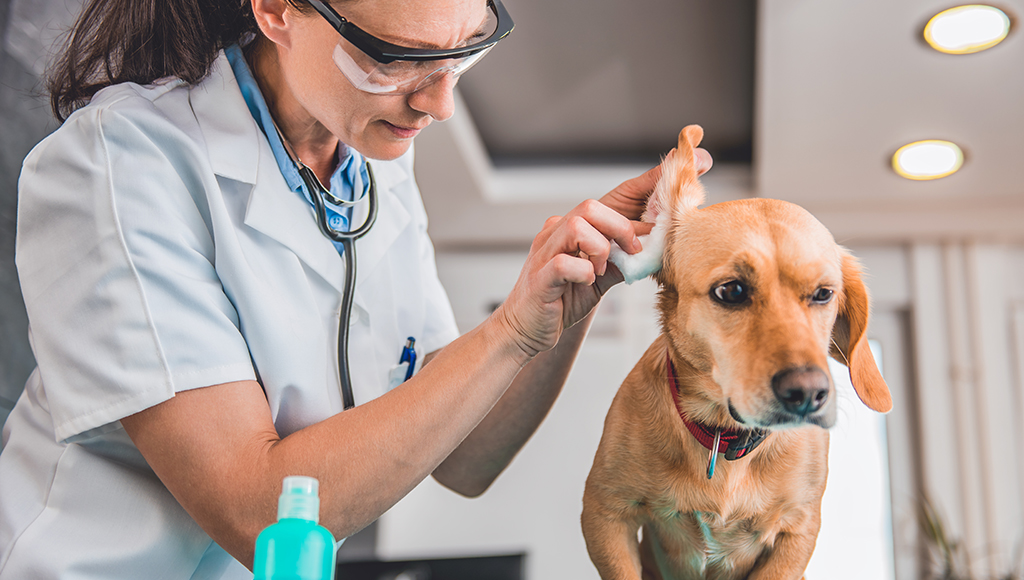Dog Ear Infections: Signs and When To See the Vet
Ear infections in dogs can be caused by a lot of different factors, and usually require medical attention.

Ear infection in dogs calls for medical attention. While some cases of this disease may heal naturally, veterinarians should be involved in the treatment process. It is essential to treat dog ear infection the moment it starts so as not to worsen your dog's condition.
How Do Dogs Get Ear Infections?
Canine ear infections are most often due to bacteria or yeast. Ear mites, growing hair, trapped water, a tumor or foreign body in the ear canal can lead to an overgrowth of bacteria or yeast. Infections may also develop when allergies, hypothyroidism or an excessive amount of ear wax are present.
Frequent bathing, swimming and incorrect cleaning methods can also lead to infections. Because a dog’s ear canals plunge downward and then horizontally from the ear opening, it is difficult for caught debris or water to be released as it must work its way upward to escape; this makes dogs especially susceptible to ear infections.
How Can I Tell if My Dog Has an Ear Infection?
The following symptoms may indicate that your dog needs to have his ears checked by a veterinarian:
- Ear scratching
- Brown, yellow or bloody discharge
- Odor in the ear
- Redness
- Swelling
- Crusted or scabby skin on the near ear flap
- Hair loss around the ear
- Wiping the ear area on the floor or furniture
- Head shaking or head tilt
- Loss of balance
- Unusual eye movements
- Walking in circles
- Hearing loss
Which Dogs Are Prone to Ear Infections?
Dogs who are prone to allergies or have floppy ears can be especially vulnerable. Cocker spaniels are one breed very prone to this disease, so it is very important for their owners to be meticulous about their grooming. Fungal infections are common to cocker spaniels because air fails to circulate freely in their ears. Air circulation is very crucial in maintaining healthy ears. With floppy ears, small follicles of hair grow in their ears, further blocking the air from coming in. These hairs are usually overlooked by pet owners and are only taken care of when dogs are brought to the grooming centers. Golden retrievers, schnauzers and poodles also tend to grow hair in the inner ear canal, making them more susceptible to ear infections.
How Are Ear Infections Diagnosed?
A veterinarian can usually diagnose an ear infection by examining the ear canal and ear drum with a magnifying ear cone similar to devices used on people. This may require sedation or full anesthesia. A sample of ear discharge may be examined to look for bacteria, yeast and parasites. A vet may also suggest blood work and allergy tests to determine the root causes.
It’s important not to self-diagnose ear problems, as improperly treated infections may lead to chronic pain or deafness in dogs. Please always allow your vet to determine the cause of your dog’s symptoms.
How Are Ear Infections Treated?
Ear infections in dogs can easily be treated and cured. Antibiotics or ear drops are usually prescribed by a veterinarian after a thorough examination. The chosen treatment depends on what actually caused the disease. Some ear infections may even be contagious. So if you have other dogs inside your home, make sure that they don't associate too much with the infected dog. Many ear infections can be treated with a professional cleaning followed by regular cleaning and medication given at home. Your veterinarian may also prescribe topical and/or oral medicine. For severe or chronic cases, anesthesia and ear flushing—or even surgery—may also be necessary.
How Can Ear Infections Be Prevented?
- Check your dog’s ears regularly for discharge, odor, swelling and other symptoms of infection.
- If his ear canal appears dirty, clean with a cotton ball dampened with a solution suggested by your vet—but don’t clean so often or deeply that you cause irritation.
- After baths and swimming, be sure to dry your dog’s ears as thoroughly and carefully as you can.
- If your dog is prone to infections, ask your vet if canine ear-drying solution would be beneficial.
- If your dog grows hair in or around the opening of his ear canals, periodically tweeze it away (if your dog tolerates it) or request that your groomer do so.
- Inner-ear skin is delicate, so ask your vet to demonstrate the proper method for maintaining your dog’s ear health.
When is it Time to See the Vet?
If your dog is showing any of the symptoms described above, see the vet as soon as possible. Please also bear in mind that even though dogs in pain don’t always show it with outward signs, a sudden increase in aggression can be an indicator of physical pain. Such behavioral changes should also prompt a veterinary exam.
Ready to start saving money on pet wellness care?
Then take a look at Mint Wellness, the pet wellness plan that provides fast reimbursement on routine pet care. Save on vaccinations, wellness exams, preventatives, dental, and more!
Learn More


